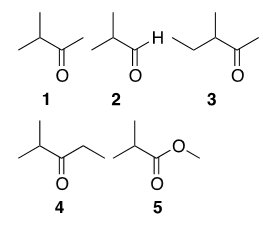Rank the following aromatic compounds in order of reactivity towards electrophilic aromatic substitution (from most reactive to least reactive):

Subscribe below to get the DAT Question of the Day delivered straight to your inbox every morning.
Rank the following aromatic compounds in order of reactivity towards electrophilic aromatic substitution (from most reactive to least reactive):

Which conformation of 1,2-dichloroethane has a zero dipole moment?

Which of the following compounds gives 3-methyl-2-butanol upon reduction with LiAlH4?

Consider the molecule below. If the CH3- and Cl- groups were switched with each other, how would you describe this new molecule relative to the one below?

Which one of the following reactions of alkenes does the Anti-Markovnikov’s rule apply instead of Markovnikov’s rule?
The absorption of what type of electromagnetic radiation results in electronic transitions?
Photo attributed to melburnian.
For carbonyls that are part of a conjugated π-network, the C=O stretch:
The 1H NMR spectrum of an unknown compound shows the following signals: triplet, quintet and triplet (relative integrals 1:2:3, respectively). Which compound is consistent with this data?
Which of the following statements best describes the structural relationship between cis-1,2-dibromocyclopropane and trans-1,2-dibromocyclopropane?
Place the following in order of LEAST acidic to MOST acidic.
